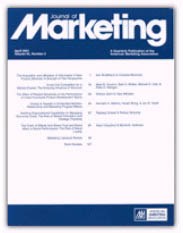
Dellaert, \BenedictG.C.\, Johnson, \EricJ.\, Duncan, S. and Baker, T. (2024). Choice Architecture for Healthier Insurance Decisions: Ordering and Partitioning Together Can Improve Consumer Choice Journal of Marketing, 88(1):15--30.
-
Affiliated authorBenedict Dellaert
-
Publication year2024
-
JournalJournal of Marketing
Making good health insurance decisions is important for health outcomes and longevity, but consumers{\textquoteright} errors are well documented. The authors examine whether targeted choice architecture interventions can reduce these mistakes. The article examines the interaction of two choice architecture tools on improved consumer insurance decisions in online health care exchanges: (1) ordering the options from best to worst based on a high-quality user model and (2) partitioning the total set of options. Although ordering and partitioning do not always improve choices separately, the authors use one field study and three experiments to identify the conditions that allow the combination to greatly improve health insurance decisions. Findings indicate that when options are ordered such that the best options appear at the beginning of the presented list, partitioning nudges consumers to focus on the best options. However, if the best options are not at the top of the list, partitioning discourages search and can impair consumers{\textquoteright} discovery of the best options. Process data show that these effects are achieved by focusing consumers{\textquoteright} limited attention on higher-quality options. These results suggest that wise choice architecture interventions need to consider the joint effect of choice architecture tools as well as the quality of the firm's user model.